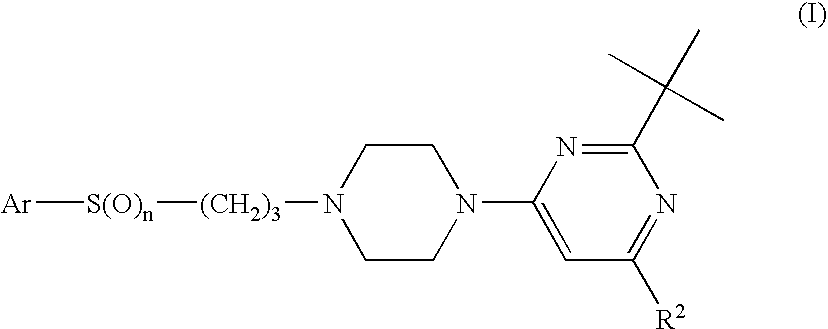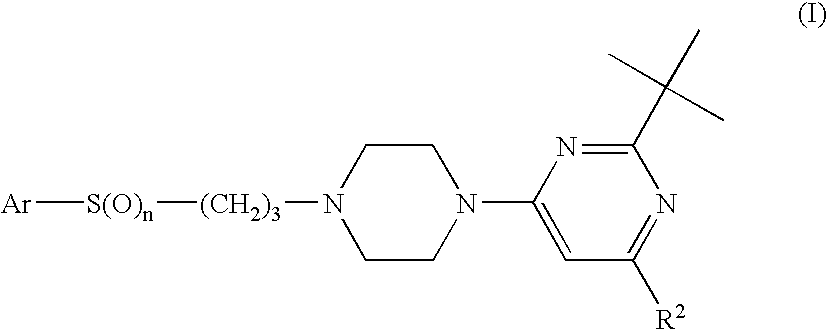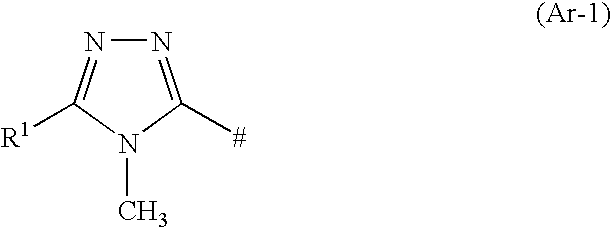Triazole Compounds Suitable for Treating Disorders that Respond to Modulation of the Dopamine D3 Receptor
a technology of dopamine d3 receptor and triazole, which is applied in the field of triazole compounds, can solve the problems of difficult to achieve high brain level with such known compounds, and the selectivity of dsub>3 /sub>receptors is not always satisfactory, and achieves high brain level and selective binding. high
- Summary
- Abstract
- Description
- Claims
- Application Information
AI Technical Summary
Benefits of technology
Problems solved by technology
Method used
Image
Examples
preparation examples
I. Preparation of Intermediates
a. Preparation of 2-tert.butyl-pyrimidine—Compounds IV
[0085]a.1 2-tert-Butyl-4-[4-(3-chloro-propyl)-piperazin-1-yl]-6-cyclobutyl-pyrimidine
[0086]a.1.1: Methyl-2-cyclobutanoyl-acetate
[0087]22 g of meldrum's acid (2,2-dimethyl-1,3-dioxane-4,6-dione) (152.7 mmol) and 36.9 ml of pyridine (457.2 mmol) were dissolved in 200 ml of dichloromethane. 18.1 g of cyclobutylcarbonic acid chloride were added at 0 to 10° C. The reaction mixture was stirred overnight at room temperature, washed with 1 N HCl and extracted with dichloromethane. The organic layer was washed with water, dried over magnesium sulfate, filtered, and then concentrated to dryness. The oily residue was dissolved in 300 ml of methanol and heated under reflux for 2 h. The reaction mixture was concentrated to dryness and the residue purified via silica gel chromatography with ethyl acetate as eluent. Yield: 21.2 g
[0088]MS (ESI) m / z: 157.1 [M+H]+
[0089]1H-NMR (CDCl3): δ [ppm] 3.7 (s, 3H), 3.4 (s, 2H)...
example 1
2,4-Di-tert-butyl-6-{4-[3-(4,5-dimethyl-4H-[1,2,4]triazole-3-sulfinyl)-propyl]-piperazin-1-yl}-pyrimidine
[0265]10 g of 2,4-di-tert-butyl-6-{4-[3-(4,5-dimethyl-4H-[1,2,4]triazol-3-ylsulfanyl)-propyl]-piperazin-1-yl}-pyrimidin (18.01 mmol) were dissolved in 300 ml water. At room temperature, 9 ml of 2 N aqueous hydrochloride acid (18.01 mmol) were added. The solution was cooled to 5° C. and 5.54 g (9.0 mmol) of oxone added in portions. After consumption of the starting material, the crude reaction product was isolated and subjected to a silica gel chromatography with ethyl acetate, ethyl acetate-methanol 15:1 to 8:1. Isolated were 1.16 g of 2,4-di-tert-butyl-6-{4-[3-(4,5-dimethyl-4H-[1,2,4]triazole-3-sulfonyl)-propyl]-piperazin-1-yl}-pyrimidine (Example 4) and 6.5 g of 2,4-di-tert-butyl-6-{4-[3-(4,5-dimethyl-4H-[1,2,4]triazole-3-sulfinyl)-propyl]-piperazin-1-yl}-pyrimidine. The latter product was dissolved in 10 ml of n-hexane and crystallized overnight in the refrigerator to yield 5....
example 2
2-tert-Butyl-4-cyclobutyl-6-{4-[3-(4-methyl-4H-[1,2,4]triazole-3-sulfonyl)-propyl]-piperazin-1-yl}-pyrimidine
[0268]38 mg were obtained as described for example 1.
[0269]ESI-MS: 462.3 [M+H]+
[0270]1H-NMR (CDCl3): δ [ppm] 8.2 (s, 1H), 6.1 (s, 1H), 4.0 (s, 3H), 3.8 (m, 2H), 3.6-3.7 (m, 4H), 3.4 (m, 1H), 2.45-2.6 (m, 6H), 2.1-2.35 (m, 6H), 2.0 (m, 1H), 1.9 (m, 1H), 1.35 (s, 9H).
PUM
| Property | Measurement | Unit |
|---|---|---|
| Molar density | aaaaa | aaaaa |
| Molar density | aaaaa | aaaaa |
| Molar density | aaaaa | aaaaa |
Abstract
Description
Claims
Application Information
 Login to View More
Login to View More - R&D
- Intellectual Property
- Life Sciences
- Materials
- Tech Scout
- Unparalleled Data Quality
- Higher Quality Content
- 60% Fewer Hallucinations
Browse by: Latest US Patents, China's latest patents, Technical Efficacy Thesaurus, Application Domain, Technology Topic, Popular Technical Reports.
© 2025 PatSnap. All rights reserved.Legal|Privacy policy|Modern Slavery Act Transparency Statement|Sitemap|About US| Contact US: help@patsnap.com



